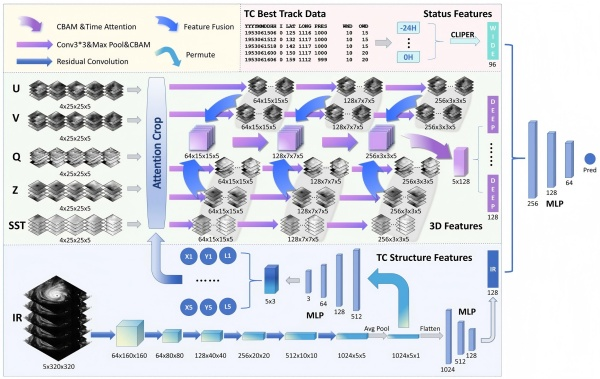The research team led by Professor Zhang Changjiang from the School of Artificial Intelligence has achieved significant progress in the field of tropical cyclone intensity forecasting recently. The study, conducted in collaboration with the Shanghai Typhoon Institute of the China Meteorological Administration and the Taizhou Meteorological Bureau, was published in IEEE Transactions on Geoscience and Remote Sensing under the title “Tropical Cyclone Intensity Forecasting Using Multimodal Data Fusion Guided by Sequential Infrared Satellite Images.”
IEEE Transactions on Geoscience and Remote Sensing is a flagship journal of the IEEE Geoscience and Remote Sensing Society (GRSS) and ranks among the world’s top five journals in geoscience and remote sensing. With an impact factor of 8.6, it is classified as a Q1 Top Journal by the Chinese Academy of Sciences and is widely recognized for its influence in remote sensing and Earth science research.
Prof. Zhang Changjiang serves as both the first author and corresponding author of the paper. The co-first author is Xu Liyu, a master’s student jointly supervised by Taizhou University and Zhejiang Normal University. Collaborators include Ma Leiming and Lu Xiaoqin, senior researchers from the Shanghai Typhoon Institute, and Wei Xue, an engineer from the Taizhou Meteorological Bureau. Ma Leiming serves as the co-corresponding author, and TU is listed as the primary contributing and corresponding institution.

Schematic of the proposed multimodal data fusion network for tropical cyclone intensity forecasting guided by sequential infrared satellite imagery
According to the paper, current deep learning methods for predicting tropical cyclone intensity are restricted by inadequate utilization of climate factors, insufficient feature fusion, and the inability to automatically adapt input data to changes in the scale of cyclone structures. To address these challenges, the research team proposes a multimodal data fusion model guided by sequential infrared satellite images (IRGMF). The IRGMF model integrates a broader range of climate factors for a more comprehensive, enriched feature representation of tropical cyclone intensity. In addition, the team designed a temporal attention module that allows the model to focus on critical moments in the sequential data for a more precise capture of the dynamic features of climate factors as they evolve. To enhance prediction accuracy, they also developed an attention-cropping module that adaptively crops irrelevant information outside the scale of a tropical cyclone from reanalysis data. To validate the effectiveness of the proposed model, they conducted experiments on multiple datasets, including CMA-BST, ERA5, and GridSat-B1. Experimental results show that, compared to existing methods, the proposed IRGMF model demonstrates significant advantages in predicting tropical cyclone intensity and provides superior accurate information for meteorological forecasting and decision support.
This research was supported by the National Natural Science Foundation of China (Grants No. 42575003 and 42075140) and the Natural Science Foundation of Zhejiang Province (Grant No. TGG24D050001).
Paper link: https://ieeexplore.ieee.org/document/11185145